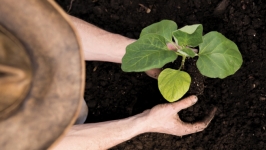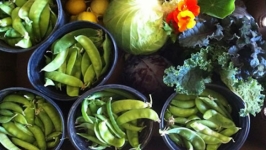Getting Started on Your Edible Garden
This year’s third biannual Edible Garden Tour starred 18 private and nonprofit gardens from San Mateo to Campbell—showcasing fractions of acreage tended by single gardeners and large swathes of land cultivated by teams of volunteers and staff.
Nestled in west Menlo Park, NanoFarms—a fledgling worker-owned cooperative garden venture started by a Catholic priest to create job security for low income families—was impressively established, with tidy rows of corn, strawberries, tomatoes, onions and tomatillos arranged in a large rectangle. Regional Manager Brendon Ford explained, “We grow organic produce that we sell at Catholic churches after mass. We have a CSA program that we’re starting now and we also build backyard gardens called nano farms where people can grow their own produce.”
At the next stop—permaculture gardener Gwyn Murray’s backyard garden—I was greeted by Prince Albert, a beautiful gray-white goose who gazed petulantly at me from the shade of an apple tree, surrounded by several duck cronies. Murray also raises bees, chickens, lion-headed rabbits and all manner of vegetables and fruits. While relaxing at her patio table, I asked Murray for some beginner advice for fall. “I’d probably plant lettuces. I personally cannot kill kale and chard, so I just let them re-seed and go crazy. And they do really well in cooler seasons,” she responded. Murray added that it helps to start with a kitchen garden, growing the sorts of vegetables and fruits you and your family enjoy eating.
Inspired by the Tour, I reached out to Joshua Thayer, owner of landscape design and consultation service Native Sun Gardens, requesting some nuggets of wisdom. “My advice to first-time gardeners is to start with an area that you can succeed in. ... Start with crops that are resilient (like beans and arugula). Grow your soil and the soil will grow your food. Invest in organic amendments and take the time … to create a fertile growing area.”
Thayer further suggests getting all the members of the household to participate. “Involve children by giving them tasks they can experience success in: planting seed, watering, collecting snails and helping harvest. For people with limited mobility, try building extra-high raised beds with a bench built into the siding so they can tend without body stress. Also create a pocket garden on a porch or balcony and utilize this space for herbs, greens and flowers.”
With California’s drought, program manager Mia Sasaki recommends planting low-water crops like citrus, herbs and roots (think sweet potatoes, radishes). And Thayer reminds us to mulch around all low-growing plants to retain moisture, thus reducing the need to water.
Want to give your green thumb a chance? Grab a garden trowel and head on out to your backyard or check out one of the adult education courses at Common Ground Garden for inspiration. Who knows? By next year your garden might be featured on the Edible Garden Tour!
Last-minute tips from Joshua Thayer to make the trek outdoors a little less daunting:
• Companion-plant the Native American trilogy of corn, beans and squash. They’ll buddy up symbiotically, creating long-term soil fertility, well-balanced nutrients to cook in your kitchen and protecting each other from predators.
• Use beans and peas as garden helpers! Legumes help fix nitrogen to give a boost to the soil and the plants around them. They also can be spaded into the topsoil to feed the soil after harvesting.
• Dilute 10 drops of peppermint essential oil with water in a spray bottle and spray any plants that are sensitive to powdery mildew once a week just before sunset to stave off infection.
• Plant flowers to attract beneficial insects. Marigold and California fuschia are especially well-suited, as they’ll feed pollinators while requiring minimal irrigation.






